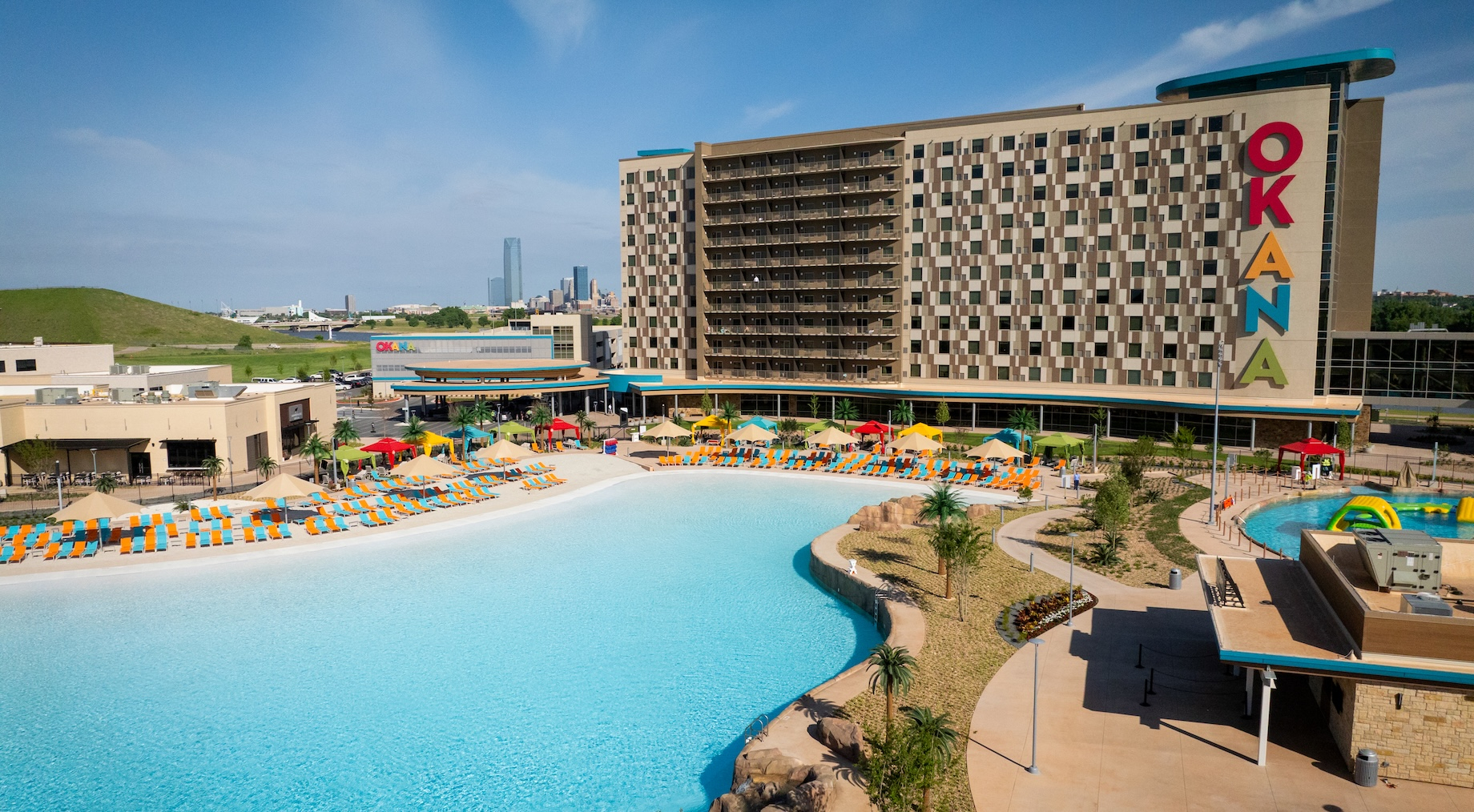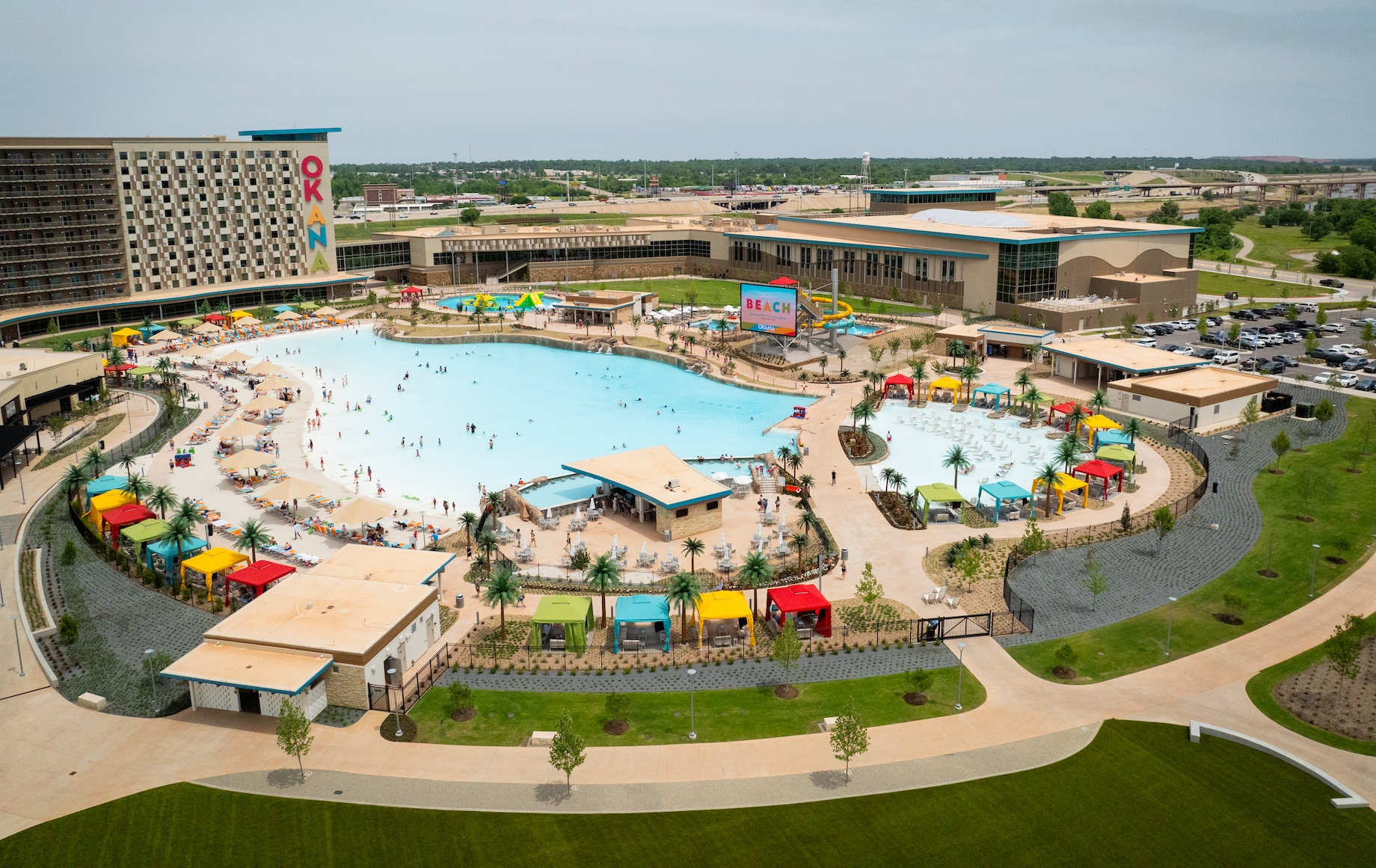The Short Version
- A 40-year public-private partnership led to the creation of the First Americans Museum and the adjacent $400 million Okana Resort & Indoor Waterpark in Oklahoma City.
- The resort includes indoor and outdoor waterparks, a hotel, dining, retail and event spaces, drawing visitors from 49 states since opening in February.
- The First Americans Museum, opened in 2021, showcases the cultures of 39 First American nations and helped catalyze development of the surrounding site.
- Okana’s development was spearheaded by The Chickasaw Nation and supported by state, city and private investment, transforming a former brownfield site.
- The project is expected to generate more than $1 billion in economic impact over 10 years and employ more than 800 people.

From Brownfield to Destination: The Story Behind Okana and the First Americans Museum
“Never again will we be a city you just pass through,” Oklahoma City Mayor David Holt said on Feb. 21, as he marked the opening of the $400 million, 40-acre Okana Resort & Indoor Waterpark.
On that day, the resort’s 404-key, 11-story hotel and 100,000-square-foot, two-level indoor waterpark opened. In May, Okana’s 200,000-square-foot outdoor waterpark with a white-sand beach and what Okana senior director of marketing Talya Regan claims is the country’s fourth-largest pool. The property also offers a conference center, a full-service spa, an amphitheater, an event lawn, an art gallery, shops, 13 restaurants and bars and a game hall featuring 100 arcade games, laser tag, a mirror maze, escape rooms and sports simulators.
The same month that second phase opened, the project received Innovation in Community honors in the ICSC Excellence in Community Advancement Awards, created this year to recognize community-advancing projects that stemmed from innovative public-private collaborations.
More 2025 ICSC Excellence in Community Advancement Award Winners
How a Public-Private Partnership — and a Court Battle — Shaped Nine Mile Corner
How a TIF Helped Transform an Empty AT&T Campus Into Bell Works Chicagoland
PGA Frisco: A Public-Private Partnership Driving North Texas’ Mega Mixed-Use Development
How Hernando, Mississippi, Turned Brownfields Into a Blueprint for Small-Town Revival
Fulfilling Holt’s words, the project has already drawn visitors from 49 states since its opening. That’s a lot of momentum in just five months, but the seeds for this transformative project were sown almost 40 years ago.

Okana Resort & Indoor Waterpark’s sundrenched 200,000-square-foot outdoor section, opened in May, features a white-sand beach and a 4.5-acre lagoon. Okana’s 404-room hotel and indoor water park debuted in February. Photo courtesy Okana Resort & Indoor Waterpark
The Long Game: From Museum Planning to Waterpark Reality in OKC
The waterpark was borne from a public-private collaboration that first created the First Americans Museum on adjacent land.
Thirty-nine years ago, said Chickasaw Nation Secretary of Commerce Dan Boren, the Oklahoma Tourism & Recreation Department recognized a longtime need for a Native American cultural and historical center and commissioned a study that led to the creation of the First Americans Museum. In 2008, the state granted $24 million for FAM’s construction on what would eventually become city land. The Chickasaw Nation and city leaders privately raised an additional $40 million toward the $175 million museum’s completion.
Oklahoma Futures, an organization of public officeholders and private businesspeople, planned the museum, analyzed demographics and located the brownfield site, home to 13 former oil wells covered by a dump holding thousands of tires and used mattresses, according to engineering and environmental consultant Terracon. Oklahoma Futures authorized a state agency, the Native American Cultural and Educational Authority, to construct and operate the museum.
In 2015, then-governor Mary Fallin signed a bill allowing the state to sell $25 million in bonds to pay for the operation and maintenance of the museum.
Two years later, the city sold the 140 acres to The Chickasaw Nation for $14 million. Though not yet announced, this acreage also would come to house Okana. And in 2018, Oklahoma City created a tax increment financing district to facilitate development of the museum and the surrounding property — including what would become the waterpark — plus a special sales-tax district for the museum, Boren said.
The 175,000-square-foot museum opened its doors Sept. 18, 2021, and showcases the collective histories and cultures of 39 First American Nations, featuring an immersive family discovery center, exhibitions, a museum store carrying products by First American artists and a restaurant serving cuisine inspired by those cultures.
In 2022, it won a Phoenix Award for brownfield cleanup and redevelopment. “To take a property like this from a brownfield to opening involves a lot of painstaking attention to detail, both in legal and realty work,” said Boren. “The legal due diligence on this project was complex, with property rights and environmental concerns due to the unusual nature of the original [property divide] and the fact the land is along the Oklahoma River.” Remediated brownfield issues at the site included petroleum contamination from dozens of former oil wells, and from a former dump where thousands of tires and used mattresses sat just above the well sites, according to Terracon, an engineering and environmental consultant that worked on the project.
Museum ownership will transfer from the state to the city when the bond issue is paid off in 2048. The nonprofit First Americans Museum Foundation will continue to operate the property until then.

Okana’s game hall features 100 arcade games, laser tag, a mirror maze, escape rooms and sports simulators. Photo courtesy Okana Resort & Indoor Waterpark
Developing Okana: A Strategic Next Step for The Chickasaw Nation
After FAM opened, The Chickasaw Nation turned its focus to Okana. Though the park was officially announced in October 2021, a month after the museum opened, the resort and waterpark long had been considered the next offshoot, particularly because it was considered an ideal land use for the rest of the parcel, Boren said. The resort and waterpark ultimately would “complement the museum and enhance the experience for visitors from not only the central U.S. region but across North America and the world,” he added.
Construction began in October 2022. Manhattan Construction Group, which served as construction planner of FAM and of the Dallas Cowboys headquarters, built most of the resort. CallisonRTKL, since acquired by Arcadis, master-planned the resort and designed its dining and retail outlets, including a Native American Marketplace. ADCI designed the hotel and waterparks, which were developed by Aquatic Development Group, while developer Wynne/Jackson assisted in the overall design of the project.
Despite soaring post-COVID construction prices, Okana came in under budget. Boren said smart planning and strong collaboration streamlined approvals and enabled efficient decisionmaking. “We partnered with top-tier leaders in design, construction and development who brought both innovation and efficiencies to the table.”
Prime Location and Nearby Attractions Fuel Okana’s Appeal
Located near the intersection of Interstates 35, 40 and 235, the museum and resort sit a short jaunt from such Oklahoma City attractions as Bricktown, the Boathouse District, the Oklahoma City National Memorial & Museum and Paycom Arena, home of the NBA’s Thunder.
Situated on the south bank of the Oklahoma River, the pair of attractions serve up traffic to each other, said Regan, and Okana’s 10,000-square-foot Exhibit C Gallery features First Americans fine art in a multi-use gallery space, in curated exhibitions and in seven rented art studios for First American artists.
Officials are enthused about the imminent completion of an Oklahoma River Cruises ferry landing to serve Okana and FAM, funded in part by a $4 million Federal Transit Administration, plus a pedestrian bridge that will allow easier foot traffic to the Boathouse District on the north shore of the river.
Tapping Into Oklahoma City’s Broader Tourism Ecosystem
Meanwhile, Okana and FAM are cross-marketing their developments with other attractions, including the Boathouse District, which features a 4,000-meter-racecourse and training courses for rowers, and the district’s $45 million Riversport Rapids center, whose McClendon Whitewater Center will host the canoe slalom event during the 2028 Summer Olympics.
Okana’s Economic Impact and the Road Ahead
Okana’s opening was a milestone for The Chickasaw Nation as it pursues broader development strategies, said Boren. Though expansion announcements aren’t yet at hand, “we’re actively evaluating future enhancements and are committed to thoughtful growth,” he said.
The Greater Oklahoma City Chamber projects the resort’s 10-year economic impact will exceed $1 billion and that it ultimately will employ 800. It may actually exceed that, as Boren said Okana already employs more than 780. The chamber’s study also predicts an uptick in tourism in the entire metro area resulting from Okana, he added. Over 10 years, it expects to collect $107 million in state taxes, $86.7 million in city taxes and $3.2 million in county taxes.
Guests from neighboring Texas make up 18% of Okana’s visitors, said Regan. But “what’s particularly exciting is that 8% of our guests are coming from beyond our traditional five-state regional market,” she said. “That indicates Okana is drawing visitors from across the country who are specifically seeking out this type of comprehensive resort experience.”
Not only has community response to the resort and waterpark “been incredible since we opened our doors,” Regan said, “we’re seeing families driving from across the region since there truly isn’t anything like Okana in Oklahoma or surrounding states. Okana is designed as a complete destination rather than just an accommodation with a waterpark, which is proving to be a perfect fit for both travelers and locals alike.

Okana claims to feature the fourth-largest swimming pool in the country. Photo courtesy Okana Resort & Indoor Waterpark
By Steve McLinden
Contributor, Commerce + Communities Today